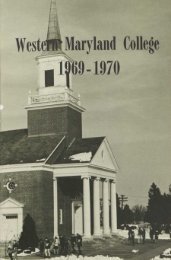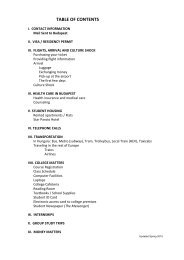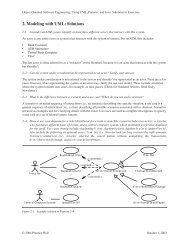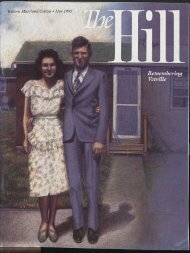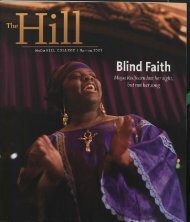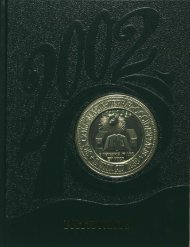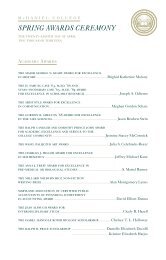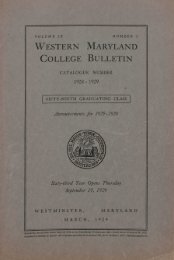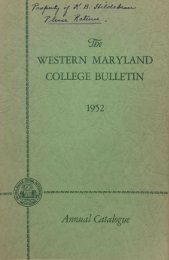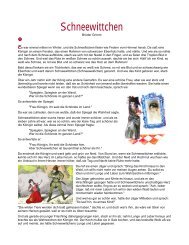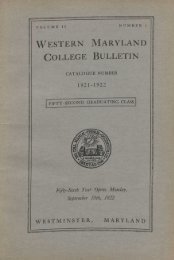western maryland college december, 1963 - Hoover Library
western maryland college december, 1963 - Hoover Library
western maryland college december, 1963 - Hoover Library
You also want an ePaper? Increase the reach of your titles
YUMPU automatically turns print PDFs into web optimized ePapers that Google loves.
On the Hill<br />
Indian<br />
on Faculty<br />
A Fulbright-Whitney visiting professor of<br />
economics from India has joined the Western<br />
Maryland faculty for this semester. Dr.<br />
M. H. Copal was one of four additions to<br />
the faculty announced by President Ensor.<br />
Returning to campus is Miss Marianne<br />
Shears, '58, instructor in English. Miss<br />
Shears was in Europe during the first semester.<br />
Miss Ruth Ann Runkles joins the faculty<br />
us a special instructor in library science.<br />
She has completed her MSLS at Drexel Institute<br />
of Technology. Mrs. Craig Schmall<br />
{Mary Lee Younger, '55) will be a graduate<br />
laboratory assistant in the biology department.<br />
Dr. Copal, a well known Indian economist,<br />
is a graduate of the University of<br />
Mysore, has an M.A. at the University of<br />
Bomhay and his Ph.D. at the University of<br />
London. He studied law at Loncoln's Inn,<br />
also in London. Dr. Gopal has taught at<br />
~'!ysore University and was research reader<br />
in public finance at Delhi University; university<br />
professor in economics at Andhra<br />
University; visiting scholar at Harvard University;<br />
professor of economics at Mysore;<br />
professor of economics, Ford Foundation<br />
Unit, University of Madras; and consultant<br />
to the National Council of Applied Economic<br />
Research. He is a member of the<br />
All-India Railway Rates Tribunal and a consultant<br />
to the Fiscal Division of the U. N<br />
in New York.<br />
The visiting professor will teach a general<br />
course called Roots of Indian Tradition and<br />
a more specialized course in Problems of<br />
Indian Economic Planning.<br />
Type A Chairman<br />
Alumni Secretary Philip E. Uhrig has<br />
rece~tly completed his first year as Type A<br />
Chmrman, District II of the American<br />
Alumni Council.<br />
Dis~ict II is the largest unit of the<br />
Coun.cll, a professional organization for those<br />
working with alumni affairs, and includes<br />
several hundred <strong>college</strong>s and universities in<br />
New York, Pennsylvania, Delaware, Maryland,<br />
N.ew Jersey, District of Columbia<br />
West Ylfginia, Canaa and several foreig~<br />
countries. The Amencan Alumni Council is<br />
divided into three types: A-gencral alumni<br />
program; B-fund raising; Cc-rrmgazines.<br />
Type. chairmen, such as Phil Uhrig, are<br />
responsible for programs at district and<br />
national conferences. The January District<br />
II conference at Cherry Hill, New Jersey,<br />
was attended hy 499 alumni workers. The<br />
Western Maryland alumni secretary devoted<br />
about a year's spare time to arranging the<br />
program and securing Type t\ speakers for<br />
the four-day conference.<br />
Type Chairmcn are elected for two-year<br />
terms. P.hil is already planning for the Conference<br />
tn January, 1965.<br />
TAKE A NEW LOOK<br />
Alumni Hall-Have you seen it As you<br />
approach the main entrance, look high above<br />
and you will see, in outline form, the bridge<br />
uf a ship with it'i five portholes, protected<br />
by six lions, interlaced with garlands, all<br />
in white, facing the west.<br />
On either side, below the bridge, you<br />
will observe two huge life preservers, also<br />
in white, symbolic of the attempt, at any<br />
cost, to save man from drowning in ignorance.<br />
Also, to the right and left immediately<br />
below the bridge, you will observe<br />
twin sets of white Ionic capitals, tantalizing<br />
reminders of the greatness of Greek<br />
scholarship, art, and philosophy bequeathed<br />
to us as part of our cultuml heritage.<br />
As you ascend the steps to enter the<br />
building you will he surprised to see overhead<br />
a frieze of sixteen lion heads, symbolic<br />
of great strength and power for your protection-our<br />
heritage from Egypt, Mycenae,<br />
and Delos. Now you enter through one of<br />
the Roman arches of brick-a singular Roman<br />
contribution. Upon entering the foyer, you<br />
may descend, to the right or left, angular<br />
staircases to a small reception room. Then,<br />
on through n narrow passage way to the<br />
by PhiliP S. Royer<br />
inner chamber containing seven stained glass<br />
windows, representative of the Middle Ages,<br />
the trivium and quadrivium of medieval<br />
scholasticism. The center window of the<br />
seven is the representation of MUSIC, an<br />
original member of the quadrivium, the<br />
advanced studies of the seven liberal arts.<br />
Entombed within this inner chamber are<br />
engraved graduate records of class rolls dating<br />
from 1871.<br />
Then, if you like, and feel physically nt,<br />
climb the back, narrow circuitous stairway<br />
to the coliseum above with its historic<br />
vaulted rooL<br />
As you sit catching your breath, review<br />
what you have seen: A hridge of five portholes,<br />
protected by six lions high overhead;<br />
twin Ionic capitals; two large life preservers,<br />
and sixteen lions protecting the approach<br />
to the three Homan arches and the seven<br />
stained glass windows.<br />
A.pleasant remind~r to us, in frozen form,<br />
of historic elements In our cultural heritage.<br />
Philip S. Royer is associate professor of<br />
music. He is an auid walker and noted these<br />
items nn Alumni Hall during an earl!J morning<br />
campus stroll.<br />
page nint;;




